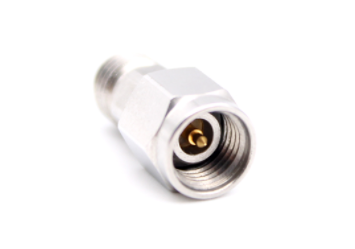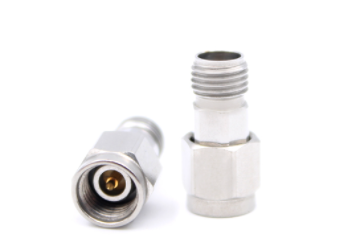The role and principle of N RF Fixed Attenuator
 Feb 15, 2022|
Feb 15, 2022| View:507
View:507N RF Fixed Attenuator is an electronic component that provides attenuation and is widely used in electronic equipment, its main uses are
(1) adjust the size of the signal in the circuit.
(2) in the comparative measurement circuit, can be used to directly read the attenuation value of the network under test.
The principle of N RF Fixed Attenuator.
The attenuator is a circuit used to introduce a predetermined attenuation in a specified frequency range. It is generally marked by the number of decibels of attenuation introduced and the number of ohms of its characteristic impedance. Attenuators are widely used in cable TV systems to meet the level requirements of multiple ports. Such as amplifier input, output level control, branch attenuation control. There are two types of attenuators: passive attenuators and active attenuators. Active attenuators are used in conjunction with other thermal components to form variable attenuators, which are used in the amplifier for automatic gain or slope control circuits. Passive attenuators have fixed attenuators and adjustable attenuators.
Composition of N RF Fixed Attenuator.
Attenuator is mainly composed of resistive materials, we are most familiar with the resistor is actually a basic form of attenuator, and the complex form of the attenuator is only the resistive attenuator network thus constituted. We commonly use the attenuator is generally to a certain frequency range of the signal attenuation, which is how to do it? Through a special process to place this resistive material in the corresponding frequency band of the RF or microwave circuit structure can be.
N RF Fixed Attenuator role.
There are two types of attenuators: passive attenuators and active attenuators. Active attenuator with other thermistors to form a variable attenuator, device in the amplifier for automatic gain or slope control circuit. Passive attenuators are fixed attenuators and adjustable attenuators.
N RF Fixed Attenuator is widely used in electronic equipment, its main uses are.
1, adjust the size of the signal in the circuit
2, in the comparative measurement circuit, can be used to directly read the attenuation value of the network under test
If some circuits require a more stable load impedance, then an attenuator can be inserted between this circuit and the actual load impedance, which can buffer the impedance change.
N RF Fixed Attenuator related parameters.
(1) Attenuation: Used to describe the amount of signal reduction from one end to the other during transmission. Can be expressed in multiples or decibels.
(2) VSWR: equal to the ratio of the characteristic impedance to the load impedance connected to the output of the transmission line.
(3) Maximum average power: The maximum power that can be added to the input of the attenuator for a long time at the specified maximum operating temperature when the characteristic impedance is connected at the output of the attenuator. When the operating temperature drops to 20ºC and the input power drops to 10mW, the other indicators of the attenuator should not change.
(4) Insertion loss power factor: When the input power from 10mW to the rated power, the insertion loss of the change value (dB).
(5) Maximum peak power: The maximum peak power of 5ms pulse width added to the input of the attenuator at the specified maximum operating temperature for the specified time when the characteristic impedance is connected at the output of the attenuator. When the operating temperature drops to 20ºC and the input power drops to 10mW, the other indicators of the attenuator should not change.
(6) Temperature coefficient: The maximum change in insertion loss within the maximum operating temperature range, expressed in dB/ºC.
(7) shock and vibration: The attenuator must withstand shock and vibration tests in three directions.
(8) insertion loss frequency response: at 20ºC, the amount of change in loss value over the entire frequency range (dB).
(9) Operating temperature limit: The maximum temperature (ºC) when the attenuator is operating at the maximum input power.
(10) Deviation of nominal insertion loss: The deviation of insertion loss from the nominal value measured at 20ºC with 10mW input power.
11)Joint life: the number of normal connections/disconnections; all electrical and mechanical indicators should meet the index requirements during the specified life.
(12) Intermodulation distortion: Intermodulation distortion consists of spurious signals, which are generated due to nonlinear factors in the device. Particular attention needs to be paid to the third-order intermodulation distortion, because the third-order intermodulation product is the largest and can not be filtered. The third-order intermodulation level is tested by injecting two pure signals of equal amplitude (f1 and f2) into the device under test, and the third-order intermodulation will appear at 2f1-f2 and 2f2-f1 of the output spectrum. The third-order intermodulation product is defined by the magnitude relative to f1 or f2 and is represented by -dBc.
(1) adjust the size of the signal in the circuit.
(2) in the comparative measurement circuit, can be used to directly read the attenuation value of the network under test.
(3) to improve impedance matching, if some circuits require a more stable load impedance, then an attenuator can be inserted between this circuit and the actual load impedance, can buffer the change in impedance.

The principle of N RF Fixed Attenuator.
The attenuator is a circuit used to introduce a predetermined attenuation in a specified frequency range. It is generally marked by the number of decibels of attenuation introduced and the number of ohms of its characteristic impedance. Attenuators are widely used in cable TV systems to meet the level requirements of multiple ports. Such as amplifier input, output level control, branch attenuation control. There are two types of attenuators: passive attenuators and active attenuators. Active attenuators are used in conjunction with other thermal components to form variable attenuators, which are used in the amplifier for automatic gain or slope control circuits. Passive attenuators have fixed attenuators and adjustable attenuators.
Composition of N RF Fixed Attenuator.
Attenuator is mainly composed of resistive materials, we are most familiar with the resistor is actually a basic form of attenuator, and the complex form of the attenuator is only the resistive attenuator network thus constituted. We commonly use the attenuator is generally to a certain frequency range of the signal attenuation, which is how to do it? Through a special process to place this resistive material in the corresponding frequency band of the RF or microwave circuit structure can be.
N RF Fixed Attenuator role.
There are two types of attenuators: passive attenuators and active attenuators. Active attenuator with other thermistors to form a variable attenuator, device in the amplifier for automatic gain or slope control circuit. Passive attenuators are fixed attenuators and adjustable attenuators.
N RF Fixed Attenuator is widely used in electronic equipment, its main uses are.
1, adjust the size of the signal in the circuit
2, in the comparative measurement circuit, can be used to directly read the attenuation value of the network under test
3, to improve impedance matching, if some circuits require a more stable load impedance, then the circuit and the actual

If some circuits require a more stable load impedance, then an attenuator can be inserted between this circuit and the actual load impedance, which can buffer the impedance change.
N RF Fixed Attenuator related parameters.
(1) Attenuation: Used to describe the amount of signal reduction from one end to the other during transmission. Can be expressed in multiples or decibels.
(2) VSWR: equal to the ratio of the characteristic impedance to the load impedance connected to the output of the transmission line.
(3) Maximum average power: The maximum power that can be added to the input of the attenuator for a long time at the specified maximum operating temperature when the characteristic impedance is connected at the output of the attenuator. When the operating temperature drops to 20ºC and the input power drops to 10mW, the other indicators of the attenuator should not change.
(4) Insertion loss power factor: When the input power from 10mW to the rated power, the insertion loss of the change value (dB).
(5) Maximum peak power: The maximum peak power of 5ms pulse width added to the input of the attenuator at the specified maximum operating temperature for the specified time when the characteristic impedance is connected at the output of the attenuator. When the operating temperature drops to 20ºC and the input power drops to 10mW, the other indicators of the attenuator should not change.
(6) Temperature coefficient: The maximum change in insertion loss within the maximum operating temperature range, expressed in dB/ºC.
(7) shock and vibration: The attenuator must withstand shock and vibration tests in three directions.
(8) insertion loss frequency response: at 20ºC, the amount of change in loss value over the entire frequency range (dB).
(9) Operating temperature limit: The maximum temperature (ºC) when the attenuator is operating at the maximum input power.
(10) Deviation of nominal insertion loss: The deviation of insertion loss from the nominal value measured at 20ºC with 10mW input power.
11)Joint life: the number of normal connections/disconnections; all electrical and mechanical indicators should meet the index requirements during the specified life.
(12) Intermodulation distortion: Intermodulation distortion consists of spurious signals, which are generated due to nonlinear factors in the device. Particular attention needs to be paid to the third-order intermodulation distortion, because the third-order intermodulation product is the largest and can not be filtered. The third-order intermodulation level is tested by injecting two pure signals of equal amplitude (f1 and f2) into the device under test, and the third-order intermodulation will appear at 2f1-f2 and 2f2-f1 of the output spectrum. The third-order intermodulation product is defined by the magnitude relative to f1 or f2 and is represented by -dBc.




